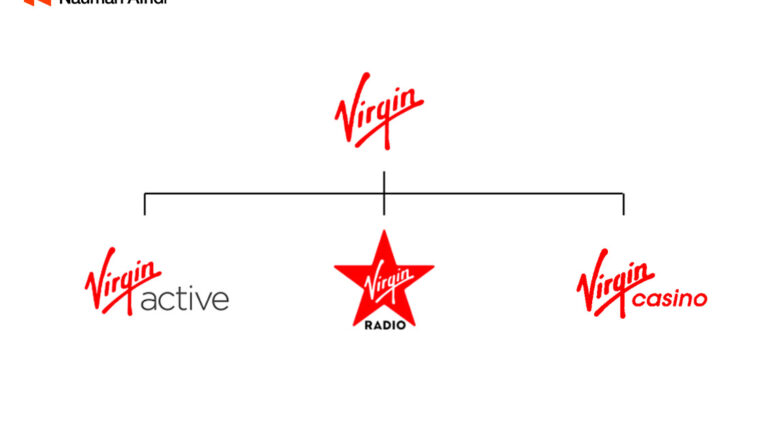Brand architecture, a critical aspect of brand management, involves organizing the hierarchy of brands within an organization. Its fundamental purpose is to bring clarity and structure to what can often be a complex and intricate branding landscape.
In the business realm, especially as enterprises expand and diversify, managing multiple products and services can lead to a tangled web of brand identities. Brand architecture acts as a strategic framework, offering a method to navigate this complexity. Think of it as a blueprint, a carefully crafted design that brings order to the chaos.
In this article, we delve into the diverse types of brand architecture, offering insights through examples from renowned brands. By exploring these real-world instances, you’ll gain valuable inspiration for shaping your own brand strategy and crafting a cohesive brand identity.
As businesses evolve and diversify their offerings, a well-thought-out brand architecture becomes indispensable. Whether you’re dealing with an array of products or a variety of services, structuring these elements coherently is crucial. This strategic approach not only simplifies internal operations but also ensures that customers comprehend the brand relationships within the organization, fostering trust and loyalty.
Join us on this journey as we unravel the intricacies of brand architecture, providing you with the knowledge and inspiration needed to navigate the complexities of your own organization’s branding landscape.
Exploring Brand Architecture
As your business expands, the challenge of managing multiple brands and offerings becomes increasingly complex. Organizing these entities cohesively is essential to maintain clarity and consistency in your brand strategy. To navigate this intricate landscape, understanding different types of brand architecture is crucial. Let’s explore four fundamental models:
1. Branded House (Monolithic)
In this model, both the master brand and its sub-brands share a unified visual identity with slight variations. For instance, FedEx employs different colors for its divisions, while Apple varies its product names.
2. Endorsed Brands
Here, the master brand lends support to sub-brands, each having its unique design to some extent. However, all sub-brands are bolstered by the visibility of the master brand. Nestle is a prime example of this approach.
3. House of Brands (Pluralistic)
In this model, the master brand is detached from sub-brands, allowing each sub-brand to have a completely unique identity. Companies like Unilever or Procter & Gamble adopt this strategy, enabling diverse product lines with distinct branding.
4. Hybrid Model
The hybrid approach involves a blend of the above strategies. Companies often start with one product or service (monolithic architecture) but expand to create entirely new brands or acquire existing ones as the company grows. Coca-Cola, for instance, utilizes a hybrid model to manage its extensive product range.
Understanding these brand architecture models is crucial because the choice you make profoundly impacts how your audience perceives your offerings. Each model comes with its strengths and weaknesses, shaping the overall brand experience. As we delve deeper, we’ll discuss the benefits and drawbacks of each approach and provide you with real-world examples to illuminate these concepts further. Stay tuned to gain valuable insights into the art of crafting a strategic and cohesive brand architecture tailored to your business’s unique needs.
Understanding the Role of the Master Brand
As we explore various brand architecture types, a fundamental question arises: what level of influence should the master brand exert over its sub-brands? Essentially, the choice boils down to determining the dominance of the master brand in shaping the identities of its sub-brands.
This decision hinges on whether the sub-brands should share the same brand identity as the master brand. This unity might involve minor alterations, such as adding a descriptor below the logo or tweaking the color palette. Alternatively, the sub-brands could be subtly endorsed by the master brand’s reputation, but still possess distinct identities.
On the other end of the spectrum, there’s the possibility of complete independence, where sub-brands have entirely new identities and operate autonomously.
To dissect these options, we’ll delve into each model, exploring real-world examples from prominent brands. By examining these cases, you’ll gain valuable insights into how different companies strike a balance between the influence of the master brand and the individuality of their sub-brands. Join us on this journey as we unravel the intricate dynamics of brand architecture, providing you with a deeper understanding of how these strategic decisions shape the overall brand ecosystem.
The Branded House Model
The Branded House, also known as the monolithic approach, is characterized by a single dominant master brand that extends its influence over all sub-brands within the organization. In this structure, all sub-brands are closely linked to the master brand, deriving their identity from it with minor modifications, such as color variations and additional extensions.
A prime illustration of the Branded House model is the FedEx brand architecture. Under this umbrella, the master brand exercises control over the entire operation. Sub-brands, in this case, bear the parent brand’s name, often accompanied by descriptors placed beside or underneath the logo. This approach, also called an umbrella or corporate brand, is evident in companies like Apple and Samsung.
In the Branded House setup, all sub-brands benefit from the visibility and reputation of the master brand, fostering brand loyalty and awareness among consumers. This model is recognized for its simplicity, requiring minimal effort to create and maintain a strong, unified brand identity. However, it may not be suitable for every company, especially those with a diverse range of offerings.
Benefits of Branded House Architecture:
- Simplicity: Building and maintaining one powerful brand is straightforward.
- Brand Loyalty: Consumers make choices based on brand recognition and loyalty.
- Focus on Brand Promise: Product features matter less as consumers trust the overall brand promise.
Drawbacks of Branded House Architecture:
- Limited Brand Meaning: The broader the business offerings, the less meaningful the brand becomes.
- Vulnerability to PR Disasters: If the master brand faces negative publicity, all sub-brands suffer.
- Rebranding Challenges: New brands resulting from mergers or acquisitions may lose their equity during rebranding efforts.
While the Branded House model has its advantages and challenges, it remains a popular choice among many renowned companies. To explore more examples of this approach, consider famous brands like Apple and Samsung that successfully implement the Branded House strategy to maintain a cohesive and powerful brand presence.
Examples of Branded House Architecture:
- FedEx: The FedEx brand encompasses various services like FedEx Express, FedEx Ground, FedEx Freight, and FedEx Office.
- Apple: Apple’s master brand extends to products such as Apple Pay, Apple iPad, and Apple iPhone.
- Samsung: Samsung’s brand covers diverse sectors including Samsung Electronics, Samsung Life Insurance, and Samsung Construction.
- General Electric: General Electric (GE) has branches like GE Energy, GE Money, GE Healthcare, and GE Aviation.
- Smithsonian: The Smithsonian brand spans entities such as the Smithsonian National Zoological Park, Smithsonian National Portrait Gallery, and Smithsonian Books.
- Coca-Cola: Coca-Cola has various sub-brands like Diet Coke, Coca-Cola Zero Sugar, and Coca-Cola Life, all under the overarching Coca-Cola master brand.
- Google: Google, as a master brand, extends to products and services such as Google Maps, Google Drive, and Google Chrome, maintaining a unified brand identity.
- Toyota: Toyota, the master brand, encompasses different vehicle models like Toyota Corolla, Toyota Camry, and Toyota RAV4, all adhering to the Toyota brand identity.
- Microsoft: Microsoft’s master brand incorporates products like Microsoft Windows, Microsoft Office, and Microsoft Azure, providing a wide range of services while leveraging the trust associated with the Microsoft name.
- Amazon: Amazon offers various services like Amazon Prime, Amazon Web Services (AWS), and Amazon Fresh, all unified under the dominant Amazon brand, ensuring consistency and recognition among consumers.
These examples highlight the diverse industries where the Branded House architecture model is successfully implemented, emphasizing the strength and unity of the master brand across a spectrum of products and services.
Endorsed Brands
The Endorsed Brands architecture model strikes a balance between the master brand and its sub-brands, creating synergy without overwhelming individual identities. In this structure, the master brand offers support to the sub-brands but with a lighter touch compared to the Branded House model. New sub-brands are developed, each with its unique identity, yet they benefit from the visibility and credibility of the master brand.
An exemplary illustration of this model is Virgin’s brand architecture, where the linkage between the master brand and its sub-brands is evident. In this approach, the new brands operate independently, entering different markets and industries. However, maintaining this balance is crucial, as an organization’s portfolio can easily become disarrayed, resembling a disjointed Frankenstein.
Marriott’s strategic implementation of the Endorsed Brands approach offers a clear example of how it can be effectively utilized. Each sub-brand under Marriott has its unique logo while being subtly supported by the master brand’s visibility. A similar strategy is employed by Kellogg’s, where sub-brands are reinforced by the presence of the company logo placed above them, ensuring both distinction and support from the master brand.
Benefits of Endorsed Brand Architecture:
- Credibility with Individuality: Sub-brands maintain unique identities while benefiting from the endorsement’s credibility.
- Positive Equity: New sub-brands draw from the positive reputation of the master brand.
- Market Flexibility: Allows competition in various markets without alienating the existing audience.
Drawbacks of Endorsed Brand Architecture:
- Crisis Impact: A crisis in a sub-brand can affect both the parent brand and peer brands.
- Time and Cost: Creating new endorsed brands requires more time and investment than the monolithic approach.
- Alignment Requirement: Sub-brands, although independent, must align with the master brand to some extent.
While the Endorsed Brands model offers versatility and distinctiveness, it demands careful management to maintain a cohesive brand portfolio. For further insight, explore my curated list of 10 renowned brands that successfully employ the endorsed model, exemplifying its strategic potential.
Examples of Endorsed Brand Architecture:
- Virgin: Virgin’s diverse ventures include Virgin Active, Virgin Radio, Virgin Media, Virgin Books, Virgin Casino, and Virgin Records, each operating with its unique identity under the Virgin brand umbrella.
- Nestle: Nestle’s extensive product lines consist of Nescafe, Nesquik, Nespresso, Nestea, Milkybar, Aero, and KitKat, among others. Each product maintains its individuality while being endorsed by the Nestle master brand.
- Kellogg’s: Kellogg’s endorses products like Rice Krispies, Crunchy Nut, Corn Flakes, Honey Smack, Krave, and Pringles, ensuring each maintains its unique branding identity while benefiting from the Kellogg’s name.
- Ralph Lauren: Ralph Lauren’s endorsed brands include Polo Ralph Lauren, Ralph Lauren Home, The Polo Bar, and Ralph’s, each offering distinct products while being supported by the Ralph Lauren master brand.
- Sony: Sony encompasses diverse sectors like Sony Electronics, Sony Pictures, Sony Music, and Sony Music Publishing, demonstrating how the master brand endorses various sub-brands across different industries.
In this model, the Endorsed Brand Architecture approach ensures a delicate balance between maintaining individual sub-brand identities and harnessing the credibility of the master brand. By exploring these examples, you can witness how prominent companies successfully implement the Endorsed brand strategy, enabling them to compete in diverse markets while leveraging the strength of their overarching brand presence.
Now, let’s shift our focus to the far right on our “Dominance of Master Brand” spectrum, exploring the House of Brands model.
Exploring the House of Brands Model
The House of Brands architecture, also known as the pluralistic approach, is a distinctive model marked by a collection of entirely unrelated sub-brands. In this structure, the master brand remains completely detached from its sub-brands. Essentially, the parent company’s name is inconspicuous, and new brands are crafted, each with its distinct identity and image. Here, the reliance on the master brand is minimal, allowing all sub-brands to operate independently with unique visuals, messaging, and positioning.
A prime example of the House of Brands strategy is evident in Procter & Gamble’s brand architecture. Often, consumers are unaware of the master brand behind popular products like Gillette razors, Tide detergent, or Old Spice deodorant. These products are marketed as individual brands, each tailored to specific audiences with their unique appeal.
Similarly, Unilever adopts a similar approach with brands like Lipton, Axe, or Dove, where each product line operates as a distinct entity with its own identity, appealing to specific market segments.
In the automotive industry, General Motors utilizes the House of Brands model by developing various car makes such as Cadillac, GMC, and Chevrolet. Each brand is positioned uniquely, catering to diverse audiences and requiring distinct brand identities.
Benefits of House of Brands Architecture:
- Niche Targeting: Sub-brands can focus on specific niche markets or venture into new categories independently.
- Diversification: Greater diversification of business and investment opportunities as each sub-brand operates autonomously.
- Flexibility in Acquisitions: Allows for easier acquisition of brands from other companies, selling existing brands, or facilitating mergers.
Drawbacks of House of Brands Architecture:
- High Costs: Creating new sub-brands involves significant expenses, including legal, creative, and marketing efforts.
- Challenges in Establishment: Establishing new brands without any endorsement poses a significant challenge in gaining recognition and trust.
- Time and Resource Investment: Building awareness for new brands demands substantial investments in both time and resources.
While the House of Brands model offers autonomy and market diversity, it demands careful strategic planning and investment to ensure each sub-brand’s success. For more examples of this model in action, explore the list below, showcasing companies that have effectively employed the House of Brands approach to navigate various market segments.
Examples of House of Brands Model
The House of Brands architecture is vividly demonstrated through a multitude of renowned companies, each with a diverse range of sub-brands operating as independent entities. Here are some notable examples:
- Procter & Gamble: Under this household name, you’ll find products like Gillette, Tide, Old Spice, Braun, Head & Shoulders, and Oral-B, each functioning with its distinct identity.
- Unilever: Unilever boasts a varied portfolio including Lipton, Axe, Dove, Ben & Jerry’s, Knorr, Rexona, Magnum, and Hellmann’s, where each product line caters to different consumer needs.
- General Motors: The automotive giant encompasses Cadillac, GMC, Chevrolet, Opel, Buick, Pontiac, and Hummer, presenting a diverse range of vehicles tailored to different market segments.
- The Kraft Heinz Company: This conglomerate houses brands like Philadelphia, Kool-Aid, and Maxwell House, each occupying a unique space in the consumer market.
- Volkswagen: Volkswagen oversees diverse car makes including Audi, Porsche, Skoda, Bugatti, and Bentley, each brand appealing to distinct consumer preferences.
- Coca-Cola: Within the Coca-Cola family, you’ll find Sprite, Dasani, Schweppes, Minute Maid, and VitaminWater, offering a variety of beverage options for consumers.
- Nestle: Nestle’s extensive lineup includes Cheerios, Nesquik, KitKat, Milkybar, Nespresso, and Gerber, showcasing their versatility in meeting consumer demands.
- PepsiCo: PepsiCo manages brands like Gatorade, Mountain Dew, Tropicana, and Aquafina, each catering to specific beverage preferences and lifestyles.
- Mars Wrigley: Under this umbrella, you’ll find products such as Doublemint, Bounty, M&M’s, Orbit, Snickers, Skittles, Twix, and Winterfresh, each with its unique taste and appeal.
- LMHV: LMHV oversees a luxurious array of brands like Christian Dior, Fendi, Givenchy, Marc Jacobs, Hennessy, Tiffany, and Sephora, each contributing to the company’s diverse market presence.
These examples highlight the vast spectrum of products and services encompassed within the House of Brands architecture. However, for organizations of immense size and complexity, a hybrid approach, combining elements from different models, might be the most effective way to manage their extensive brand portfolios.
Hybrid Brand Model
The Hybrid Brand Model represents a strategic blend of various branding approaches within a single organization. This hybrid architecture incorporates elements from different models, allowing some sub-brands to be linked to the master brand, while others operate independently.
This approach commonly emerges when a company initiates with a single brand and later expands by creating extensions or acquiring new, separate brands to enhance competitiveness. For instance, Google initially adopted a monolithic architecture for products like Google Pay, Gmail, and Google Drive. However, as the company grew, it created independent brands like Android and Chrome. Moreover, Google acquired companies such as YouTube and Waymo, leading to a complex branding landscape. To streamline this complexity, Alphabet, a holding company, was established, redefining Google as a sub-brand with its own set of sub-brands.
Coca-Cola followed a similar trajectory, starting with a single product and then expanding into extensions like Diet Coke. With growth, they acquired and developed entirely new, unrelated brands like Sprite, strategically maintaining brand separation to diversify their market presence.
Another illustration of the Hybrid Brand Model is evident in The Walt Disney Company. While they utilize a Branded House approach for brands like Walt Disney World, they also own independent entities like ABC and Marvel, which operate without any direct linkage to Disney.
Benefits of Hybrid Brand Architecture:
- Versatility: The hybrid model offers the advantages of both standalone and interconnected branding strategies, providing flexibility to adapt to diverse market demands.
- Mergers and Acquisitions: It facilitates the integration of different types of brands, allowing for mergers and acquisitions while maintaining distinct identities.
- Creative Flexibility: Some sub-brands can adopt new identities, while others can maintain a close association with the master brand, allowing for creative freedom.
Challenges of Hybrid Brand Architecture:
- Complex Decision-making: Determining which sub-brands should be independent and which ones should be endorsed can be perplexing, leading to strategic decision challenges.
- Maintenance Efforts: Keeping brand guidelines updated across the board becomes a significant challenge due to the diverse nature of the hybrid model.
In essence, the Hybrid Brand Model provides organizations with a unique opportunity to navigate the complexities of the market by combining different branding strategies, allowing for adaptability and strategic diversification.
Examples of Hybrid Brand Architecture
Hybrid Brand Architecture, as exemplified by various successful organizations, demonstrates the strategic amalgamation of different sub-brands within a single overarching brand. Here are some noteworthy examples illustrating this approach:
- Google: While Google Pay and Gmail operate as direct extensions, Google also encompasses independent brands like YouTube, Android, and Waymo, showcasing a mix of interconnected and stand-alone entities.
- Coca-Cola: Alongside core products like Diet Coke and Coke Zero, Coca-Cola extends its portfolio with distinct brands such as Sprite, Dasani, and VitaminWater, offering a blend of related and unrelated products under one umbrella.
- Walt Disney: While the iconic Walt Disney World and Disneyland fall under the Disney brand, the company also owns independent entities like Disney+, ESPN+, Marvel, and ABC News, showcasing a diverse range of offerings to various consumer segments.
- Marriott: Marriott maintains a consistent brand identity across sub-brands like Courtyard and SpringHill Suites, yet also manages distinct entities including The Ritz-Carlton, Sheraton, and W Hotels, reflecting a strategic blend of interconnected and independent branding.
- Microsoft: Microsoft encompasses widely-used products like Office and Windows, along with separate entities such as Skype, Xbox, and Bing, offering a mix of integrated and stand-alone digital services.
- Amazon: Core services like Amazon Prime and Amazon Fresh share the brand with other entities like Amazon Kindle, Whole Foods, Zappos, and Twitch, presenting a diverse yet interconnected brand landscape.
Final Thoughts on Brand Architecture
The key to effective brand architecture lies in envisioning the future trajectory of the company and strategically linking these diverse entities. It is not solely the realm of large corporations; even smaller brands with varied offerings can leverage brand architecture for their growth.
For instance, a real estate business like Ami Corp. with diverse products catering to distinct audiences successfully utilized brand architecture. By adopting the Branded House model, they maintained a consistent logo while incorporating differentiating colors and descriptors, akin to the approach adopted by FedEx.
In conclusion, these real-world examples underscore the importance of a well-thought-out brand strategy. Whether for multinational giants or budding enterprises, brand architecture serves as a potent tool for navigating diverse market demands, ensuring brand coherence, and stimulating growth. Feel free to share any unique examples or insights in the comments below, as brand architecture continues to evolve in innovative ways.






![What Is An Endorsed Brand [Examples, Benefits & Disadvantages]](https://naumandigital.com/wp-content/uploads/2023/02/20-600x400.jpg)


![Premium Pricing Strategy [Pros, Cons & Top Examples]](https://naumandigital.com/wp-content/uploads/2023/10/WhatsApp-Image-2023-10-24-at-1.46.51-PM-600x400.jpeg)